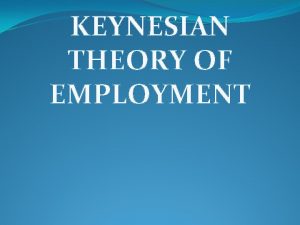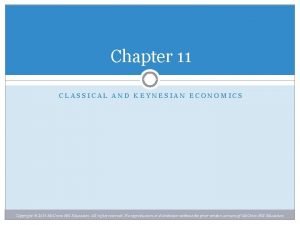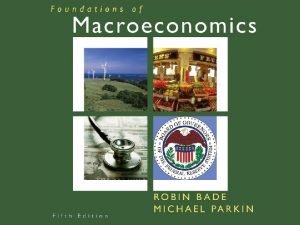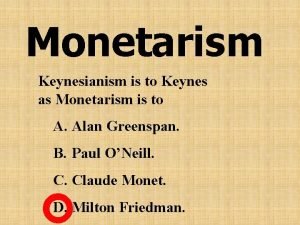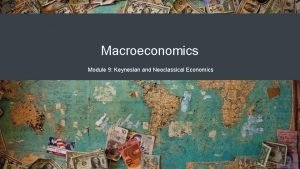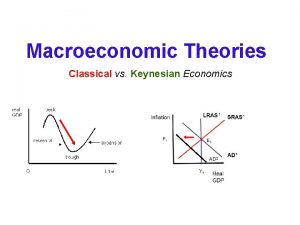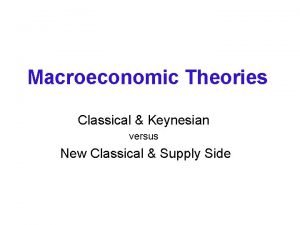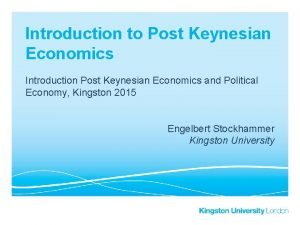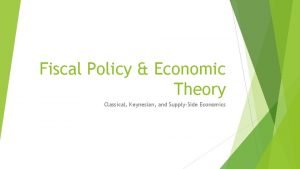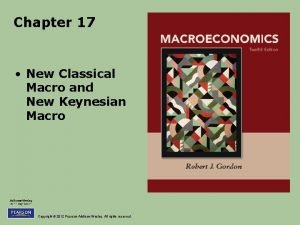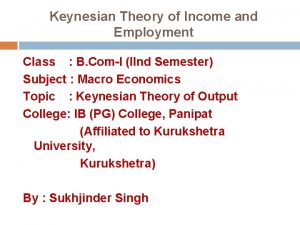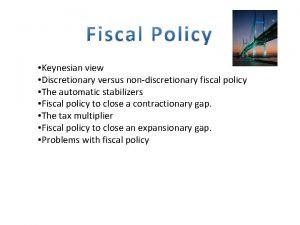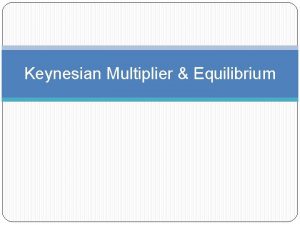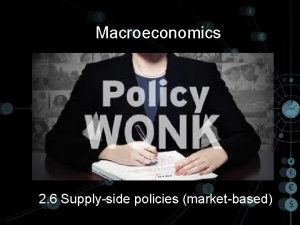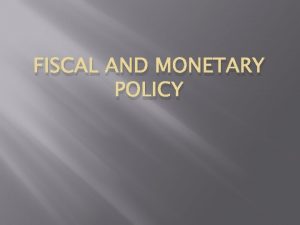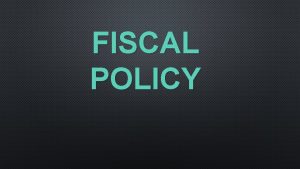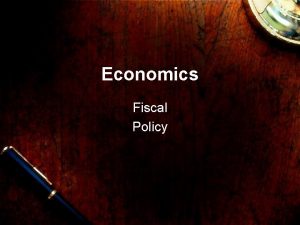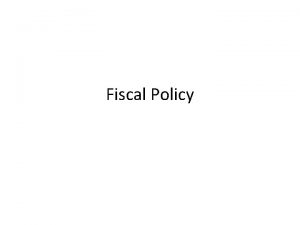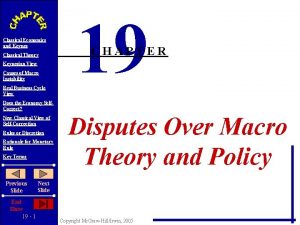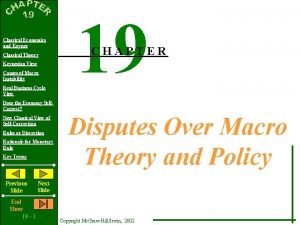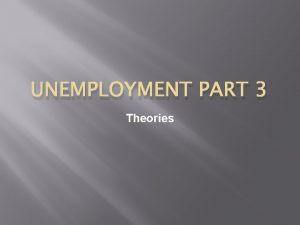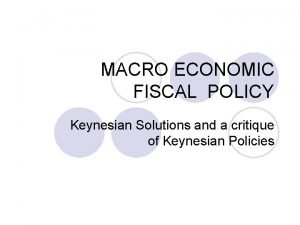Fiscal Policy Economic Theory Classical Keynesian and SupplySide
















- Slides: 16

Fiscal Policy & Economic Theory Classical, Keynesian, and Supply-Side Economics

Fiscal Policy Fiscal policy is the use of government spending and revenue collection (taxes) to influence the economy. Just like the Federal Reserve has “tools” to influence the economy, the government does too. The Federal Reserve sets monetary policy. The US Government sets fiscal policy. The federal government spends about $250 million every HOUR, roughly $6 billion each DAY and about $2. 2 trillion a YEAR. All this cash flow can impact aggregate demand supply and have an impact on our economy.

The Federal Budget Fiscal policy involves making decisions about how much the government should spend and how much they should tax and is used to achieve three things: Economic growth Full Employment Price Stability Decisions about spending and taxation happen during the creation of the federal budget each year. The federal budget is a document that indicates how much the government expects to receive and authorizes the amount of money the government can spend each year. Just like families have a household budget, so does the government. The federal budget is proposed by the President and appropriated by Congress for the next Fiscal Year (Oct. Sept). Federal Budget FY’ 17

Steps of the Fiscal Policy Process Step 1: Agencies submit proposals to advocate for funding to certain areas of the country. Examples: Department of Education, Defense, National Security Step 2: Executive branch draws up a budget Step 3: Congress debates the proposal and drafts several revisions until they approve a final budget. Step 4: The budget gets approved it is sent back to the President for final approval. What if the president disapproves?

Fiscal Policy and the Economy Contractionary The government utilizes two types of fiscal policy – expansionary and contractionary. Expansionary policies aim to increase output (GDP) by increasing Government spending and lowering taxes. Expansionary Increase: Aggregate Demand, Prices, & Output Contractionary policies aim to decrease output (GDP) by decreasing Government Spending and increasing taxes. Decrease: Aggregate Demand, Prices & Output

Expansionary Policy Intended to encourage economic growth and production Increase Government Spending – when Government spending increases, it triggers a chain of events that raises output and creates jobs. Decrease Taxes When Government spending increases, aggregate demand will increase which will cause an increase in prices. The higher prices will encourage suppliers to make more goods, which will create more output and the need for more employees. Expansionary policy fixes problems with unemployment and recession.

Contractionary Policy Intended to slow economic growth in certain phases of the business cycle. Decrease Government Spending Increase Taxes If Government spending decreases, aggregate demand will decrease which tends to lower prices and lowers inflation. Contractionary policy fixes problems related to inflation.

Limits of Fiscal Policy Difficulty changing spending levels Can’t predict the future Delayed results – takes time to implement changes Politics- Who implements Fiscal Policy? ? Getting all levels of government on board

Different Theories on Economics Throughout history, there has been debate about fiscal policy (how a government should spend money and tax the people). These debates have been referred to as economic theories. Classical Economists Keynesian Economists Supply-Side Economists

Classical Economists Prominent Economists – Adam Smith, David Ricardo, and Davis Malthus Core belief – Lassiez-faire policies; economies are self-regulating in the long-run and free markets will always get back to equilibrium eventually The government shouldn’t intervene, just let things in the economy play out and let competition drive it. BIG IDEA: Classical Economists believe in as little government influence in the economy as possible. Lassiez-faire and people acting in their own self-interest should allow the economy to naturally reach equilibrium.

Keynesian Economists Prominent Economists – John Maynard Keynes formed his theory on economics during the Great Depression as he saw the horrible conditions that came from the free market system. Keynes believed that during a recession or depression, consumers and businesses demand less. If the government could intervene and spend money, it encourage production and employment. When people got back to work, they would start consuming again (demand more). This mind-set is known a “demand-side” economics – involves changing demand to help the economy. BIG IDEA: In times of need (depression/recession), the government can help the economy by increasing spending. An increase in government spending would help give people more jobs and increase demand. Once the recession or depression ended, the government should step out of economic affairs again. Keynes argued that governments could influence demand by changing their spending habits and changing taxes (fiscal policy). Said that a change in spending or taxes could have an impact of a multiple that is greater than the initial spending or tax. This is known as the multiplier effect.

Keynes V. Hayek We just learned about how Keynes supported government spending in times of need, but he was challenged by Friedrich von Hayek claimed that the government and central planners were unable to make rational decisions in an economy, and spending in times of economic downturn would actually make things worse. Keynes and Hayek lay the foundation for one of the most heated debates in economics: Classical Vs. Keynesian.

The Fight of the Century

Supply-Side Economists Prominent Economists – Arthur Laffer Promoted a supply-side approach to fiscal policy. Supplysiders believe that taxes have strong negative influences on output and the focus should be on increasing aggregate supply not demand. The Laffer Curve Laffer believed that high taxes do not mean more revenue if the tax causes spending/investment to decrease. BIG IDEA: If the government cut taxes, businesses would hire more people, increase output, & total employment would increase and the government could collect even more taxes at the lower rate.

Deficit v. Debt Every fiscal year, the federal government begins with a “balanced budget” on paper. This is the idea that the same amount of money is going in (tax revenue) and out (government expenditures) of the US Treasury. In reality, the federal budget is almost never balanced and that there is always a surplus or deficit. Surplus happens when the revenues collected (taxes) exceed expenditures. Deficit happens when the revenues collected are less than the expenditures. Print/create Borrow more money (creates inflation) more money Commonly borrows money by selling bonds (T-bills, notes, bonds; can be short-term or longterm) Sometimes borrows from other nations (National Debt)

The National Debt The problem with borrowing money is that it creates a national debt (money owed to bondholders). For every year that the budget operates in a deficit the national debt will grow. The more bonds sold, the higher the debt. If you have a bond in your name, the government owes you money. Deficit and debt are not the same thing. Deficit is the money borrowed to cover the expenditures in one fiscal year. Debt is the accrual of government borrowing up to that time minus any borrowing that has been repaid. The Crowding-Out Effect: when the level of federal borrowing makes it more difficult for private businesses to grow. When the federal government spends more than it takes in, it must borrow money from banks. The banks are then forced to charge higher interest rates to businesses when they borrow so that they can compensate. This decreases private investment funding.
 Keynesian and classical theory
Keynesian and classical theory Keynesian view
Keynesian view New classical macroeconomics
New classical macroeconomics Monetarist vs keynesian vs classical
Monetarist vs keynesian vs classical New classical and new keynesian macroeconomics
New classical and new keynesian macroeconomics Keynesianism
Keynesianism Neoclassical economics
Neoclassical economics Classical economics vs keynesian
Classical economics vs keynesian Monetarist vs classical economics
Monetarist vs classical economics Keynesian policy
Keynesian policy Classical economics vs keynesian
Classical economics vs keynesian Keynesian vs classical vs monetarist
Keynesian vs classical vs monetarist Explain the keynesian theory of employment
Explain the keynesian theory of employment Graphing monetary and fiscal policy interactions
Graphing monetary and fiscal policy interactions Unit 3 aggregate demand aggregate supply and fiscal policy
Unit 3 aggregate demand aggregate supply and fiscal policy Tax multiplier formula
Tax multiplier formula Define non-discretionary fiscal policy
Define non-discretionary fiscal policy
